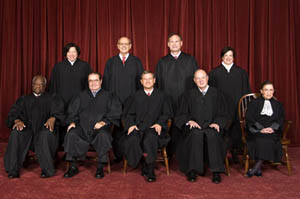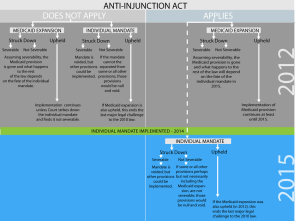
The challenge to the Affordable Care Act that the U.S. Supreme Court will consider this March involves a series of complex and inter-related legal questions. How the court views each one — including the constitutionality of the law’s individual mandate and Medicaid expansion, as well as the application of the Anti-Injunction Act and the question of severability — will trigger a cascade of related decisions. What the court finds will determine whether the measure is implemented in whole, in part or at all.
With Stuart Taylor as a guide, Kaiser Health News provides this diagram to help see how the sweeping health law’s implementation could proceed — or not — based on each of these questions.
Although the Anti-Injunction Act does not apply to the constitutionality of the Medicaid expansion, the diagram is designed to show how the various decisions related to each could potentially interact.

| Individual Mandate | Anti-Injunction Act | Medicaid Expansion | Severability |
| This provision of the health law requires people not covered by group plans to buy government-approved health insurance by 2014 or pay a penalty. | A statute that bars federal courts from striking down tax provisions until they have taken effect, and thus would require delaying any decision on the individual mandate until 2015 if its penalty is deemed a “tax.” | A provision requiring states to extend Medicaid coverage to people with incomes up to 133 percent of the federal poverty level in order for the states to keep their federal matching Medicaid funds. Some states say this will compel them to spend too much on their share of the match. | If the court strikes down the individual mandate or the Medicaid provision, it will then decide whether that voided provision or provisions can be separated from the rest of the law. If some cannot be separated, the non-severable ones would be dead. |






